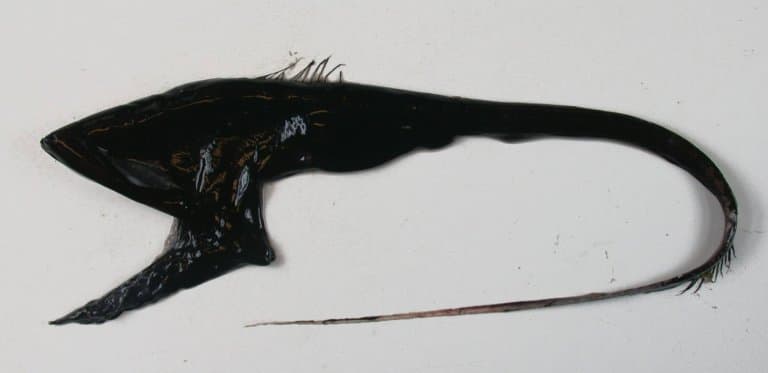It may have massive jaws, but the gulper eel’s ultra-black skin ensures it remains well hidden in the depths of the ocean

Compared with the enormous size of their jaws, gulper eels (Eurypharynx pelecanoides), also known as pelican eels, have one of the tiniest skulls of any animal. The enormous jaws allow them to swallow whatever prey they happen upon in the vast space of the deep sea, where food is hard to come by.
“The upper and lower jaw are so big that when its mouth is closed and folded up it’s almost half the length of its body,” says Yi-Kai Tea, a Chadwick Biodiversity Fellow at the Australian Museum in Sydney. “The head is right at the tip.”
The metre-long gulper eels live at depths of more than 7km under the surface, although typically they are found in the midnight zone at about 1,000 metres. Their jaws unfold to immense dimensions, like an umbrella.
“A lot of these deep-sea creatures are so intractable that they often come with schematic drawings of how they work,” says Tea. “Their anatomy is so far removed from what is normal, it’s hard to imagine what they’re actually like.”
Pelican eels were one of the many deep-sea fish found on a recent expedition to the Cocos (Keeling) Islands in the Indian Ocean, exploring little-known waters around giant underwater mountains. Tea was a fish expert on board, part of the team that slowly dragged a four-metre-long beam trawl net just above the seabed, as far as 6,000 metres down. After four or five hours the net would come back up to the ship and the team would sort the catch.
“That’s the fun thing about being on an expedition like that … you never really know what is coming up in those nets,” says Tea. “It’s really just the luck of the draw.”
As well as their massive mouths, gulper eels also have incredibly stretchy skin that can accommodate an enormous gulp of food. A young gulper eel showed just how stretchy they can be, when it was caught on camera in 2018 on the flanks of a seamount 1,425 metres underwater in the Papahānaumokuākea marine national monument near Hawaii.

Inflated with water, it looked like a black balloon with two beady eyes. Then it folded its skin away and swam off with sinuous waves of its snaky body. It remains a mystery what that particular fish was up to. Perhaps it was trying to look big and scare off the noisy, bright submersible that was filming it, or perhaps it was just stretching its muscles. “I don’t think anyone really knows,” says Tea.
The Cocos (Keeling) expedition was the first time Tea saw a fresh, net-caught gulper eel and witnessed its incredibly black skin, which soon fades in preserved museum specimens. “They’re so intensely, deeply black it looks weird and fake,” says Tea. “It’s almost as if you’re looking into a black hole,” he says. “That really blew my mind.”
A recent study revealed how gulper eels and other deep-sea fish engineer their ultra-black skin. Melanin pigments are arranged in such a way that photons of light bounce between them, like a ball pinging around inside a pinball machine, and few escape. More than 99.7% of the light that falls on the skin gets absorbed, making gulper eels almost as black as the artificial superblack coatings constructed from carbon nanotubes that suck in light and let next to none back out.

Ultra-black skin helps gulper eels avoid being illuminated by their bioluminescent prey, such as lanternfish, which have glowing lights along their bellies. “It doesn’t want to be seen, it wants to be well hidden,” says Tea. “The outer blackness of its skin helps it to blend in well in its surroundings.”
Source: theguardian.com








